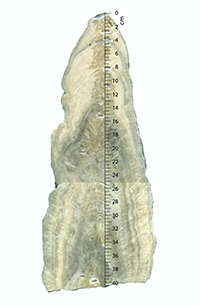|
Climate Change Drove Late Assyrian Empire Ebb and Flow: Study
November 14, 2019
Climate change helped contribute to the last rise and the eventual fall of the might Assyrian Empire, researchers say. The researchers collected samples from stalagmites in Kuna Ba cave, near Nineveh, the heart of the ancient Assyrian Empire. The civilization was a power in the area in and around Mesopotamia for more than a century. At its height, the Assyrian Empire stretched from what is now southern Iraq to the Mediterranean coast. Its first phase began about 2500 B.C. Stalagmites have growth rings, much like trees do, and the researchers built a timeline of the empire's last years through close examination of the rings and what they contained. Stalagmites, because they grow up from a cave floor, can provide a picture of the amount and composition of rainwater over time. The researchers looked for changes in the ratios of oxygen isotopes at various points in the stalagmite growth rings, seeking a correlation with rainwater levels that would correspond to rainfall outside the cave. Stalagmites also trap uranium, and so the researchers were also able to provide relatively accurate dates for the changes in rainwater levels and, therefore, overall rainfall. The last step was to compare known dates and events in the historical and archaeological records with the findings generated by examination of the stalagmite growth rings. As an example, the Assyrian king Sennacherib, who ruled 705–681 B.C., was known to have ordered built a large system of canals and other irrigation-related structures. Examination of the rainfall levels during this suggest that this construction was done during a time of very low rainfall and that the king was trying to make what little rainfall they had go further. The end of the Assyrian reign was effectively the sacking of Nineveh in 612 B.C. by the Babylonians and the Medes. Significantly, the researchers found that the last great rise of the Assyrians coincided with a period of unusually wet weather, during which crops would have flourished and created an environment in which an empire could maintain a stable populace. By contrast, the demise of the empire took place in a period of great drought, during which crops and, ultimately, people would have starved, creating conditions ripe for unrest. At the same time, the agricultural abundance that would have been prevalent during the time of great rains would have created a surplus, leading to large amounts of trade and, in turn, large amounts of revenue, fueling the empire's bureaucracy and military. Also in the same way, a lack of crops during the great drought would have restricted not only the amount of food available to feed the military, governance officials, and population at large but also the amount of revenue generated from foreign sales of that grain and other agricultural products. In general, people who suffer through tremendous economic hardship tend to try to do something about it, either by rising up in defiance of whatever entity is ruling them or by moving out of the area entirely. Either result would have been an extra headache for an empire already reeling from the effects of climatic change. Leading the study were Ashish Sinha, professor of Earth and climate sciences at California State University, and Xi'an Jiaotong University' associate professor of global environmental change Gayatri Kathayat. |
|
Social Studies for Kids
copyright 2002–2024
David White





